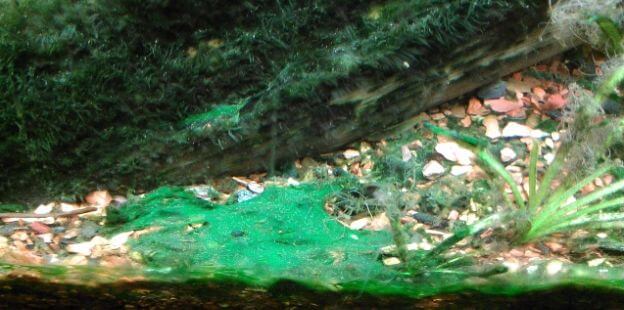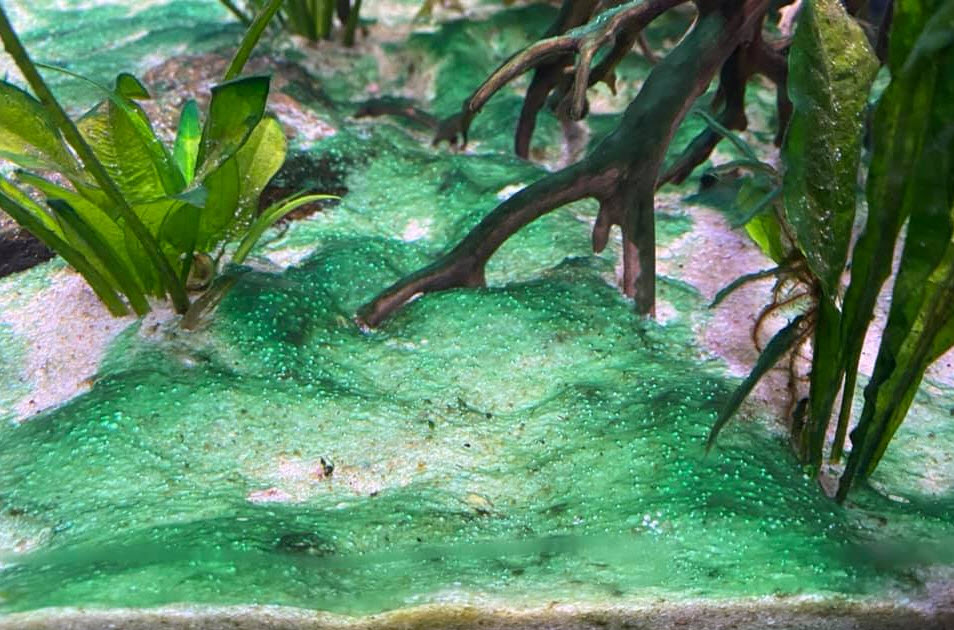
What is “Blue Green Algae”?
“Blue Green Algae” is not an algae. It is a bacteria form called a cyanobacteria. The name cyanobacterium is derived from the Greek word for “blue”: κυανός. Cyanobacteria is normally blue-green in color, as the name suggests. But cyanobacteria can also be yellow green, reddish brown or even purple.
And there are thousands of types of cyanobacteria. So, like all discussions of algae, one can only talk in generalities about the MAJORITY of cyanobacteria doing this or doing that. For instance, most cyanobacteria like warmer water and typically one only gets really severe outbreaks in warm water. But a cold water lake, Lake Erie in the USA, had a severe cyanobacteria outbreak which closed down some water plants. Cyanobacteria also TYPICALLY have a certain smell but it is very common not to have any smell.

What Causes Cyanobacteria?
Cyanobacteria is a bacteria, so it behaves somewhat differently than a typical algae, which is a plant. Cyanobacteria (“blue green algae”) is TYPICALLY caused by some combination of:
- low water movement
- high water temperature
- high phosphates
- low oxygen content in the water
But some cyanobacteria can give outbreaks where these factors are not in play at all.

Preventing or Curing Cyanobacteria
The easiest way to stop cyanobacteria is to simply attack the four items above.
- Add water movement with a wavemaker
- Lower the water temperature (NEWSFLASH: Most tropical fish do just fine at anything over 70 degrees!)
- Do LARGE water changes to get down the phosphates (NEWSFLASH: A 95% water change is harmless to fish!)
- Aim the wavemaker at the surface to get “choppy waves”. Or add a decent sized pump and air stone
Oftentimes all four courses of action are required. MOST of the time this will control the cyanobacteria.
Like almost all bacteria cyanobacteria are found virtually everywhere and it is impossible to keep cyanobacteria out of an aquarium. Cyanobacteria spores can be found floating in the dust in the air and in chlorinated tap water.

Cyanobacteria in Depth
Some species of blue green algae will change their color depending on the color of the light to make photosynthesis more efficient. Red-blue light will lead to an increased production of the substances that make the cyanobacteria green, while green yellow orange light will lead to an increased production of the substances that makes the cyanobacteria red. The purple colored algae above is cyanobacteria which is probably growing under a cheap LED light that has a white light in only the green-yellow-orange spectrum:
Some types of cyanobacteria live alone, while others form colonies. A colony can for instance look like a blue-green sheet on the water, long thread-like filaments or a hollow ball.
In nature when large heavy cyanobacteria blooms are found there is sometimes some toxins produced which are dangerous for humans. The types of cyanobacteria found in aquariums do not have the conditions necessary for the formation of toxins so they are safe to work around and safe with fish. They are just very unsightly.

Chemical and Antibiotic Treatments of Cyanobacteria
Since cyanobacteria are indeed bacteria, antibiotics such as amoxicillin, tetracycline or erythromycin (“ChemiClean”) work against cyanobacteria. The effect of the antibiotics is only temporary.
Antibiotics can on occasion kill the beneficial bacteria in a biofilter, contrary to the claims made on the package for some of the antibiotics. Using antibiotics in an established aquarium can spike ammonia and nitrites and can stress some fish. The operative word is “can”. Sometimes the filter is unaffected. Sometimes only the ammonia spikes and sometimes only the nitrite spikes. Note that since a filter will neutralize antibiotics it should be pulled off line for antibiotic treatment of cyanobacteria.
One should NEVER use chemicals other than antibiotics (which really are not “chemicals”) to control cyanobacteria. ALL chemicals which kill algae CAN also kill fish. Tetra Algae Control (API AlgaeFix is the same chemical) has killed whole tanks of fish. Excel is another killer. And both chemicals and antibiotics will provide only a temporary respite, the cyanobacteria will come back. One needs to remove the root causes.

“Snake-oil” Treatments
Ultralife Blue Green Slime Stain Remover is snake oil and will do nothing for cyanobacteria. Quoting the supplier:
“Ultralife Blue-Green Slime Stain Remover has been specially formulated to combat the problem of blue-green slime, using a secret mix of natural ingredients, supplements and biological accelerators to provide the ultimate blue-green slime stain remover.”
Any time you see the words “secret mix of natural ingredients” you know it is snake oil. There is no way to prevent any competitor from getting all the ingredients with just about $500 in testing by any competent lab. And the word “natural” in any description should be a flag that screams “fraud” to anyone.

“Special” LEDs to Control Cyanobacteria
One web write up advocated using high priced LED lights to eliminate cyanobacteria as cyanobacteria “use a different light spectrum than plants do“. This is simply a vendor trying to make some money. While cyanobacteria CAN use the orange-yellow-green part of the spectrum, their main energy source is the same blue-crimson-purple spectra as plants. A reference is useful here:
“Cyanobacteria in the environment”, Mur et. al., 1999
“Like algae, cyanobacteria contain chlorophyll a as a major pigment for harvesting light and conducting photosynthesis. They also contain other pigments such as the phycobiliproteins which include allophycocyanin (blue), phycocyanin (blue) and sometimes phycoerythrine (red) (Cohen-Bazir and Bryant, 1982). These pigments harvest light in the green, yellow and orange part of the spectrum (500-650 nm) which is hardly used by other phytoplankton species. The phycobiliproteins, together with chlorophylla, enable cyanobacteria to harvest light energy efficiently and to live in an environment with only green light.”
In any case high priced LEDs have just as much green light as do the low priced LEDs. Only the purple grow lights (both expensive and inexpensive) don’t have yellow-green light.

Contrary to popular myth cyanobacteria are not inedible. Catfish, mollies and algae eaters do eat cyanobacteria.
Like all things in the hobby, cyanobacteria have their share of myths. Some of the myths include:
- fish do not eat cyanobacteria
- cyanobacteria in the aquarium produce toxins
- “probiotics” can control cyanobacteria
.
All these are simply myths
.
Here is a link to an article on controlling algae in general, with the note that cyanobacteria are not algae and tend to respond to different things than true algae responds to.:
16.2. Controlling Algae
Return to Algae Menu
.
Aquarium Science Website
The chapters shown below or on the right side in maroon lead to close to 400 articles on all aspects of keeping a freshwater aquarium. These articles have NO links to profit making sites and are thus unbiased in their recommendations, unlike all the for-profit sites you will find with Google. Bookmark and browse!
.
